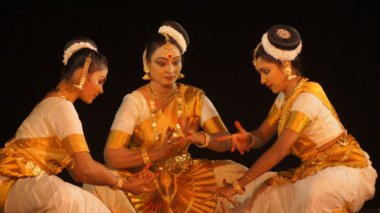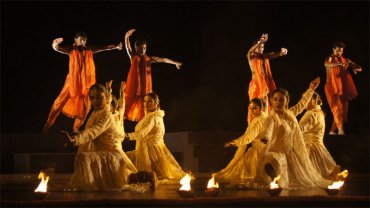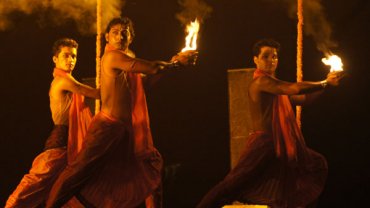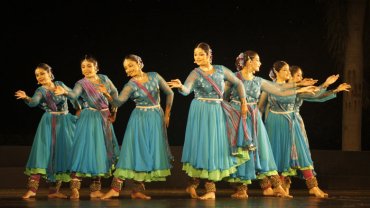
|   |

|   |
Dance Unparalleled - Shveta Arora e-mail: shwetananoop@gmail.com Pics: Anoop Arora October 24, 2013 ‘Ananya – the unparalleled’ is a festival of classical group dance choreography. The venue of Old Fort, lit up as the backdrop, is unparalleled. The breezy evenings in Delhi at this time of the year are a respite. The hundreds of diyas flickering at the entrance are a sight to behold. Ananya is a dialogue of Indian classical dance with a heritage monument. The event was organized by department of art, culture and languages, government of Delhi, Sahitya Kala Parishad and Seher in collaboration with Doordarshan, from the 2nd to 6th of October 2013 

Pallavi Krishnan
and group
On 3rd October, Pallavi Krishnan and group from Trichur
performed Mohiniattam. Pallavi is known for her
versatility as a performer, choreographer and teacher. She
is the alumnus of Santiniketan and Kerala Kalamandalam.
Pallavi has been the artistic director of Lasya Academy of
Mohiniattam since 1994. About the concept of the
performance, she said, “Panchabhuta or the five elements
have been connected to the human body based on Adi
Shankaracharya’s Soundarya Lahari and Ananda Lahari. When
Shiva and Shakti unite, the whole universe is created and
the highest evolved animal is the human being, who is then
connected to panchabhuta – mooladhara chakra to earth,
manipooraka to water, swadishtana chakra to fire, anahada
chakra to air, vishudhhi to sky and then the agni chakra
between the eyebrows is connected to the mind. In the
brain is the sahasrara chakra where a thousand lotuses are
abloom. Devi lives in solitude with her consort, Shiva.
The solo in the performance is based on Swati Tirunal’s
composition, since we are asked to stick to traditional
pieces only.”The evening was a very breezy one, so much so that it became difficult to light the ceremonial lamp. The ambassador of Afghanistan, Shahid Mohammed Abdali, was the chief guest. The first item of the performance was a Ganapati Stuti in raga Puraneer, adi talam, invoking the blessings of Lord Vighneswara. Ganapati, the elephant god, is depicted by swaying elephant ears and trunk. He is chaturbhujam, prasannavadanam, vighnopashantaye, paramanandam. The lord was shown as moving in a procession of dundubhi players and devotees with chavar and chhatra, blessing all. Next, Pallavi did a solo padam Chaliye kunjan mo in raga Brindavana Saranga, adi talam. The nayika is requesting Lord Krishna to accompany her to the garden. Pallavi showed the flowers and the bees hovering over them. Dekho Yamuna re bahi sunder - she showed the fullness of the Yamuna while enacting stepping in the water playfully, ati neer bhari. “How can you take your hand away, Lord, while I am still holding it,” the nayika says in a hurt tone. She draws his attention to the songs of the cuckoo - Suniye koyal ke bol, piye kya kehri. Pallavi depicted the embrace, romance and kiss through abhinaya. Pallavi and her group concluded with Panchabhuta - the five eternal elements. The choreography begins with the concept of Shakti, the universal energy. The union of Shiva and Shakti yields the Panchabhuta – ether, wind, fire, water and earth. The life forces come from these elements. The most evolved of the natural world, man is the prototype of the macrocosmic universe. Seven energy centres or chakras are housed in him. Adi Shankaracharya says in Soundarya Lahari that the five cosmic elements correspond to the lower five chakras. Kundalini resides at the base of the spine, the mooladhara chakra in three and a half coils. Rising up through the psychic centres, it reaches the top of the head, the sahasrara, as man experiences the final truth. While depicting the theme, the dancers did stances to show the union of Shiva and Shakti - Shiva shaktaya yukto. Then they went on to show the five elements – the sky, the flowing movement of the wind, the flaming movement of fire, the drops of water collecting to form a rivulet and then a river moving in waves, the earth with its plantation, the trees that house the birds and the animals. The five chakras of the body were shown to correspond to the five elements. The energy rising from the spine to the sahasrara in the form of a lotus and finally the performance ended with the group portraying Shiva with his damru in one hand and Shakti blessing all. Technically, an excellent piece to portray a very abstract theme 

Lok Chhanda
Cultural Unit
Maitreyee Pahari’s objective has been of preserving,
promoting and propagating the traditional culture of rural
India. She has received training in Kathak from Vaswati
Mishra and Pandit Birju Maharaj. She has majored in
Manipuri dance from the Rabindra Bharati University. She
was awarded the Charles Wallace Fellowship in 2003. She is
the artistic director of the Lok Chhanda Cultural Unit.
She presented ‘Maharaas’ in an amalgamation of the two
forms Kathak and Chhau. While the two forms are quite
distinct from each other, the dancers portrayed the
feminine aspect through Kathak and the masculine through
Chhau.  Lok Chhanda Cultural Unit
Anurag, the second part, was the union. The monsoon is over and with the sighting of the crescent, preparations begin for the special night of the full moon, the night of Maharaas. While the nayikas adorn themselves, Krishna appears and dances with each one of them. The costume change was red lehengas for the Kathak dancers and white dhotis for the Chhau dancers. The depiction begins with description of the beauty of Radha – Mohini, sunder, sohini, vaa ki chhav ko varne sake naa. She is referred to as ‘vrindavaneshwari, ujjwala, rasika, rasapriya, haripriya.’ To show the Maharaas, the Kathak dancers played manjiras - Raas mandal gopi gopal baal - then the group danced in the raas formation. Suddenly, Krishna disappears from amongst them. The pride of the gopis makes him go away. The pain struck sakhis look for him everywhere - Piya bin nahin aave chaina, viraha satave ab din raina - suffering pangs of separation and then yearning for reunion. The final part of the performance was ‘Moksha – the ultimate reunion.’ The soul yearns for this union with God - Sarvadharmaan paritajya maam ekam sharanam vraj. The dancers came on the stage in white and saffron costumes holding flaming lamps in their cupped hands. A cloud of fumes engulfed the dancers, giving it all an ethereal look. The performance ended with some fast chakkars. Shveta Arora is a blogger based in Delhi. She writes about cultural events in the capital. |